Effigy and breaststrops tell ... (Tombstone in the study of weapons of Western knights of the era of 1170-1659.)
What is effigy (from Lat. Effigies)? Just a sculpture lying on a gravestone and made of stone or wood. There is also a breaststroke - an engraved image of a figure on a flat metal sheet. It was usually brass. In the Middle Ages, these sculptures depicted the departed in a lying and kneeling form, or standing, and were placed over the grave of knights, spiritual personages, other representatives of the nobility, or, for example, "women with position". Known and paired effigii or brass, portraying a husband and wife (and, sometimes, a wife with two husbands, or a husband with four wives, of course, dead at different times!). Known and paired images of men in armor. The pose was characteristic, but depended on time and fashion: the right hand could rest on the hilt of the sword, and the palms were folded. Feet depicted standing on the figure of a lion or a dog, or a figure was kneeling with prayer-folded hands, and yes even in half a turn to the viewer.
The value of effigy is very high, since they are well preserved, although some of them are badly damaged by time, or even through the efforts of unreasonable people. After all, genuine weapons and especially armor of the XII - XIV centuries. found very few, literally a few units. There is only one chain mail, there are several rusty "big helmets", only three felcen swords, although a lot of more traditional swords were found in the same Thames. “White armor” has survived in much larger numbers, but many of them are remodels made much later than their time, so we know about the earliest knightly armor mainly from miniatures from manuscript books. But these pictures are very small and you won’t see anything there. And effigias, even damaged ones, still often look much better than the same statues of knights standing on city squares. After all, knights were usually buried under the floor of churches and cathedrals, and it is clear that their effigies were also under the roof. The roof protected them from the vagaries of the weather, but the people in the church didn’t “vandalize” either, although in the same France during the years of the French Revolution, many effigies were smashed even in churches and abbeys. But almost every English church has preserved at least one or two effigii, and the most valuable have fences, as they are monuments of national culture. And just looking at them, British stories are being studied by knightly armaments, comparing finds with stone images. Let's “ask” a few effigies and braces and listen to their leisurely story ... However, sometimes this story will be “not quite a story”, since the effigies themselves ask us more questions than they answer, and nevertheless ...
It is believed that the earliest royal effigy belonged to King Edward II (1327), well, and then the British began to set them in large numbers over the graves of all their departed. But this is not the case at all! For example, an English historian such as Christopher Gravette considers the oldest figure to be William Longspy from the Salisbury Cathedral, which roughly refers to 1230 - 1240.
She later suffered, but was restored in the XIX century, and did not become worse. But there are effigii of Robert Berkeley from Bristol Cathedral, 1170 of the Year, Jeffrey de Mandeville, Essex's first Earl, 1185 of the year (although he himself died in 1144!), William Marshall, the second Earl of Pembroke (ibid - 1231) and many others, including the nameless, which are considered earlier. Especially many such gravestone sculptures appeared in the XIII - XIV centuries, and on them we see knights with swords and shields. Someone's head rests on a special pillow, while others have a helmet instead. Effigiya with her head covered with a helmet is only one, and why she is so, why the sculptor did not paint the face of the deceased is unknown. The legs usually lie on the dog - a symbol of devotion, or on the figure of a lion - a symbol of the bravery of the deceased.
It is good that there are so many efigy, because it was them who used the aforementioned Christopher Gravette as a source of information in his book “Knights. History of English Chivalry "(Exmo Publishing, 2010) and also David Nicole in his major work" Weapons and Armor of the 105 – 1350 Crusade Epoch "(the first volume in which weapons of knights of Western Europe are dedicated).
It is simply wonderful that the sculptors at that time very accurately conveyed all the details of the weapons, and even the rings on the chain mail. Then it can be easily compared with the findings of archaeologists, if any, or with drawings in manuscripts.
Here, for example, Geoffrey (or Jeffrey) de Mandeville's effigy, of which C. Gravette wrote that she refers to the 1250 year. It is not so important whether this is the correct date or not. More interesting is the fact that he wears a very distinctive “helmet pan” on his head, which has a strange “chin rest” similar to either a metal plate or a thick leather belt. The same helmet is on a miniature depicting the murder of Thomas Beckett, the end of the XII or the beginning of the XIII century. And here is a riddle: if it is made of metal, then ... it would be impossible to put this helmet on your head! Unfortunately, this effigy is badly damaged, and does not provide an exact answer to this question.

Geoffrey de Mandeville, ca. 1250 d. Despite the fact that the effect is pretty badly damaged, it is quite possible to consider the bowler hat and its strange “chin rest” on it
Effigia (approx. 1270-1280) from Peshevors Abbey in Worcestershire is also nameless, but it is known for being covered with surcoats, the cuirass is clearly visible on the clasps. That is, at that time they were already worn, although the material from which they were made is unknown, since it could be not only metal, but also leather. A similar cuirass is also noticeable on the effect of Gilbert Marshall, the fourth Earl of Pembroke (d. 1241), which makes it possible to conclude that the spread of such armor in England as early as the middle of the XIII century. On the knees of the figure the kneecaps are clearly visible, and it means that at this time they were already worn. But in Denmark, judging by the sculpture of Birger Persona (d. 1327, the cathedral of Uppsala), at that time the robes of chain mail were very old-fashioned and without any additional plates. It is very important that effigy allow us to consider the cut of the then chain mail. On one, for example, the rows of rings on the sleeves went across the body, but there were also chain mails with fractional weaving. It is also interesting that sometimes the craftsmen transmitted the smallest details of weaving, and sometimes they only marked the rows of rings, that even some historians could come up with a basis for all sorts of amazing chain mail of leather strips, with rings on them and other fantastic designs. Today, British historians are unanimous that the chain mail was one, albeit with different types of weaving, but the sculptors were either in a hurry or just making a mess, and this is what made this kind of “mail mail fantasy”.
At the end of the XIII century. the chains attached to the handles of swords and daggers, apparently, so that the knight could not lose them, entered the knightly fashion. Usually the opposite end of such a chain was attached to a knight on his chest. But the question is - why? And in the brasse of Sir Roger de Trumpington (Trampington Church in Cambridgeshire, d. XNumx), we see that from his helmet the chain goes to ... the rope belt - and this is the earliest example of this fashion. A cross-shaped hole was made on the helmet, a barrel-shaped “button” was attached at the end of the chain - this was where it was kept behind the knight’s back!
On the effect of John de Abernon II (d. 1327) there are no such chains. But on the other hand, we see that he has a very voluminous mail hood, which indicates that he had ... he had a lot of things on. No wonder many knights in battle (as shown by us miniatures!) Did not wear helmets. Under this hood it would be possible to hide a small helmet of the servilera type easily!
John de Northwood (c. 1330, Minster Abbey on Sheppi Island, Kent) had a chain to the helmet, fastened by a hook on the chest, protruding from a metal outlet. On later effects, such sockets are already paired, or the chains pass through the slots on their surcoats and already there, under it, they were fixed at the knight's cuirass. Why on the cuirass, and not on the mail? And because no folds in the attachment points of these chains are visible! It's funny that from the beginning of the XIII century. and until the end of the XIV century, these chains are found almost on every statue, and judging by the sculptures, the knights of Germany especially liked them. There, their popularity was so great that there were not three, but four, although it was difficult to understand why the fourth was needed. It is hard to imagine how a man could fight, holding in his hand a sword with a chain four feet long (besides, often gold!), Which stretched from the hilt of his sword to the socket on his chest. After all, she could wind around his arm, could cling to the head of his horse, or the weapon of her opponent. Besides, could the chain easily get tangled in his stirrups? But, the knights all either ignored it, or knew how to fight so that all these chains would not be confused. It is possible that with the “zipper” on the jeans they would have no less trouble!
On William Fitzralph's breaststroke, (d. 1323), there are no chains either, apparently in England they didn’t receive such a spread, but the surface of the chain mail was covered by metal plates on his legs and legs. to the "white" armor!
The colored effigiy of Sir Robert du Beuys (d. 1340, city church in Forsfild, Norfolk) is known for all the attire of which is covered with heraldic ermine fur. And then the question arises: what, and the helmet and gloves he has embroidered cloth, or were they just painted? And many mods walked, closing the armor almost completely, flaunting bright and expensive fabrics!
It is precisely effigii that make it clear that knights wore not one helmet on their heads, but often two, one on top of the other. The “big helmet” with slits for eyes and breathing holes covered the whole head, but another servilera and then bascinet covered the top of the head, therefore it was very difficult to hit the knight with a blow to the helmet! Later, the bascinet received a head-on, and its tip stretched up, and it acquired an independent meaning. Moreover, it could be that the bascinet was worn constantly, and to participate in the horse attack, the squires helped the knight to take it off and put a “big helmet” on his head, with the coat of arms of a bizarre look. Interestingly, a knight could have one image on the coat of arms, but a helmet-figure could represent something completely different!
As for the “helmets with horns”, the effigies made it possible to find out that they were attached not to the helmet itself, but to something like a tire that was on top of it. It is clear that they were made from something quite light, for example, papier-mâché or thin skin, but they had to have a strong frame so as not to fall from it at the jump!
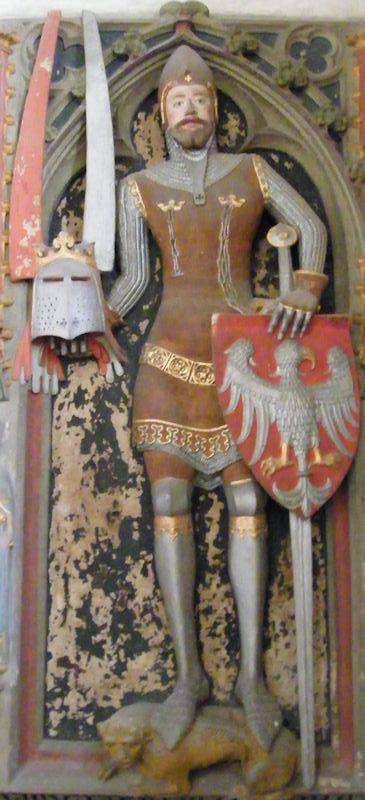
Albrecht Effigy II, 1350, shows a chain jutnik bretch attached to a helmet-bascinet and a large helmet with a crown and colorful horns. Surco has three chains: one for the helmet and two for the sword and dagger.
Interestingly, the bascinet helmets got the visor even earlier than solid-forged armor came into fashion, and the metal chin-up collars that protected the neck from being hit with a spear, the knights already received in the middle of the XIV century. According to Sir Hugh Hastings’s breaststroke (St. Mary’s Church in Elsing, Norfolk), it can be judged that the chin rest - buliver and bascinet with a visor fixed on two loops, he wore already in 1367 year, and it means that he was quite happy with such armor then and he was an approximate king, not a poor man, and he could choose. True, the buvier was fastened on top of the chainmail collar! That is, new and then side by side with the old!
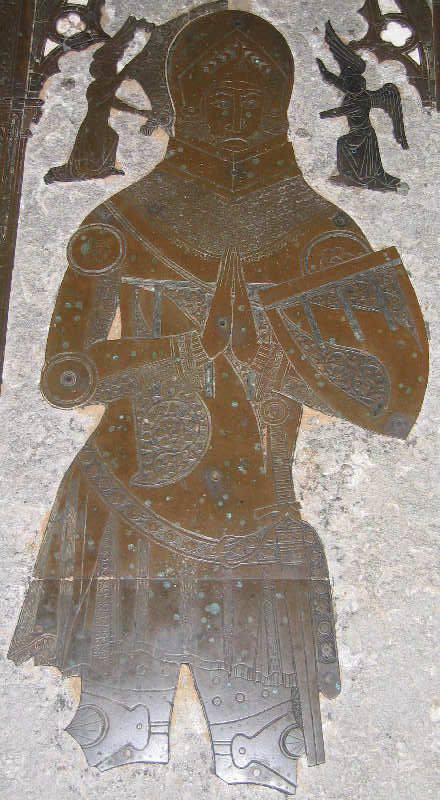
Famous gravestone bronze figure - Xga Hastings brass, mind. 1347 was in armor with protruding knee pads, in padded plates, and a helmet-bascinet with a visor. A special feature of the armor is the plate-like collar-bouvier, which is reinforced on the chain mail avantyle.
In 1392, the practice of decorating tombstones included brass or “brass” —that is, flat engraved brass sheets fastened to such a plate with the image of a knight resting beneath it.
Studying effigies and breaststrokes, it can be noted that the weapons shown on them usually represented a single instance, that is, there was no “serial production” of armor, although, of course, the chain mail with hoods could be very similar to one another. At the same time among the armor there is evidence that the human imagination never knew the limits. Thus, the knight Bernardino Baranzoni (ca. 1345 - 1350) from Lombardy distinguishes not only a mail nennik bretash, but also a short kolchuzhny barmitsa hanging from a helmet. Why did he need her? After all, his neck and so closes the chain mail hood? His mail was wide, as if at a robe, the sleeves to the elbows, but under them were seen one more sleeves, narrow, with bulging elbow pads, that is, he was wearing multi-layer armor!
For example, John Betteshorn (died 1398, Mere, Wildshire) had “white armor” on his feet and on his hands, a helmet-bascinet with a chain mail barmitsa, but the torso was tightened either with a cloth or leather, but what's under it, Alas, do not make out.
That is, again, effigii clearly show that there was a period when the knights wore “bare” mail armor, then they began to wear surcoat on top of them, then under it there was a cuirass, which was for some reason closed and the “era of knights in multi-layer armor” which was eventually changed by the era of one-piece "white armor". But here it was not so simple. Many knights continued to wear nalatnye clothes even over their beautiful Milanese armor!
One of the most unusual effigies can be seen again in England, in the church in Kangsington, although there seems to be nothing special about it. But this figure of an unknown knight is wearing a monastic cowl over his armor. And then the question arises: did he wear this all the time, or did he become a monk before his death, and with this outfit of his they wanted to emphasize this? Alas, we will never get an answer to this question.
In 1410, we see effigy showing knights who no longer have even a piece of cloth on their armor. But if the “white armor” at that time already existed, then still the breaststroke of John Oudeval (d. 1415) shows us the old type of armor on the hands and, again, the mail armor-aventyle ... under the armor of all-metal plates! He has a typical bascinet on his head, but under his head there is a huge “big helmet” that could be worn right over the bascinet!
Brass Richard Beauchamp, Earl Warwick, referring to 1450, shows us the full "white armor" of the Milan sample. Headrest serves as a tournament helmet “toad head”, decorated with a crown and a swan's head. The armor of William Wadgam (died 1451) of Flemish work. The left shoulder pad is much larger than the right shoulder and comes to the cuirass, and this proves that the knights did not use shields at that time! Richard Quartermain (d. 1478) had on his armor a huge left elbow pads, which also confirms this.
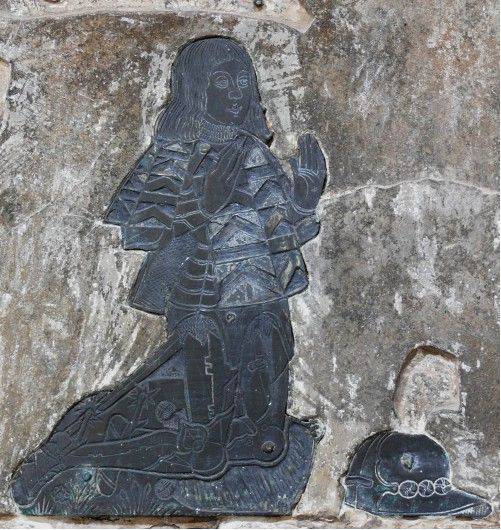
William de Gray, 1495 Mr. Marton, Norfolk. Next to it, a salad helmet is clearly visible with enhanced front-side armor.
Swords of knights on effigiy and breaststrokes are usually shown hanging on a sword belt obliquely, and the dagger on “white armor is depicted as if it were simply riveted to a plate skirt, so that it would not be lost under all circumstances. At the beginning, when the knights' belt was worn on the thighs, the dagger was hung on it. We see this in John De Lion's 1350 effigy of the year, and he has a dagger just hanging on his belt, on a cord, which is seen very well. However, later, he was abandoned and replaced with a sword belt, and the dagger was attached directly to the plate "skirt."
Well, the most famous effigy in England is, without a doubt, a sculpture of Edward, Prince of Wales, the eldest son of King Edward III, nicknamed the "Black Prince", who died in 1376 and was buried in the Canterbury Cathedral. Interestingly, black shields with images of three white ostrich feathers are visible on its sarcophagus. This is the so-called “shield of the world”, especially for tournaments, and it was he who, and not the black color of his armor, was obliged to give this nickname. Moreover, they were practically invisible, since he wore a heraldic Djupon embroidered with British leopards and French lilies!
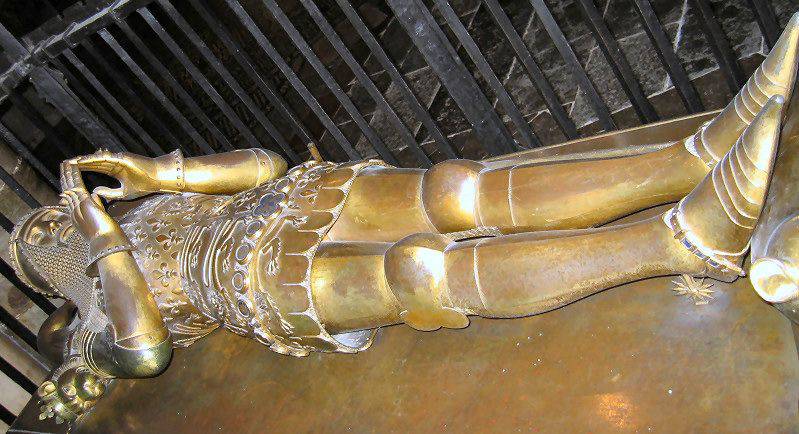
Effigiya "Black Prince"
Surprisingly, mail as a means of protection continued to be used later. So, on the John Leventorp 1510 breaststroke of the year (St. Helena's Church, Bishopgate, London) you can clearly see the chain mail skirt, visible from under the brass plates, attached to the cuirass to protect the hips. And the rest of his armor is quite modern, and suddenly on you - again for some reason, chain mail!

Henry Stanley Brass, 1528 with a chain mail skirt and tasset over it
A similar skirt of chain mail is also shown on the 1659 breaststroke of the year - Alexander Newton from the Brazilian church in Suffolk! And again, if a typical “Walloon sword hangs on his thigh on two straps, then ... the“ kidney dagger ”(with two cones in the place of the guard) is likely to be simply stuck to this chain mail shirt! And pay attention to the year! Even on earlier breasts, for example, Edward Filmer 1629 (East Sutton, Kent), the armor, as a rule, only covers the hips, and below we see pants and high cavalry boots!
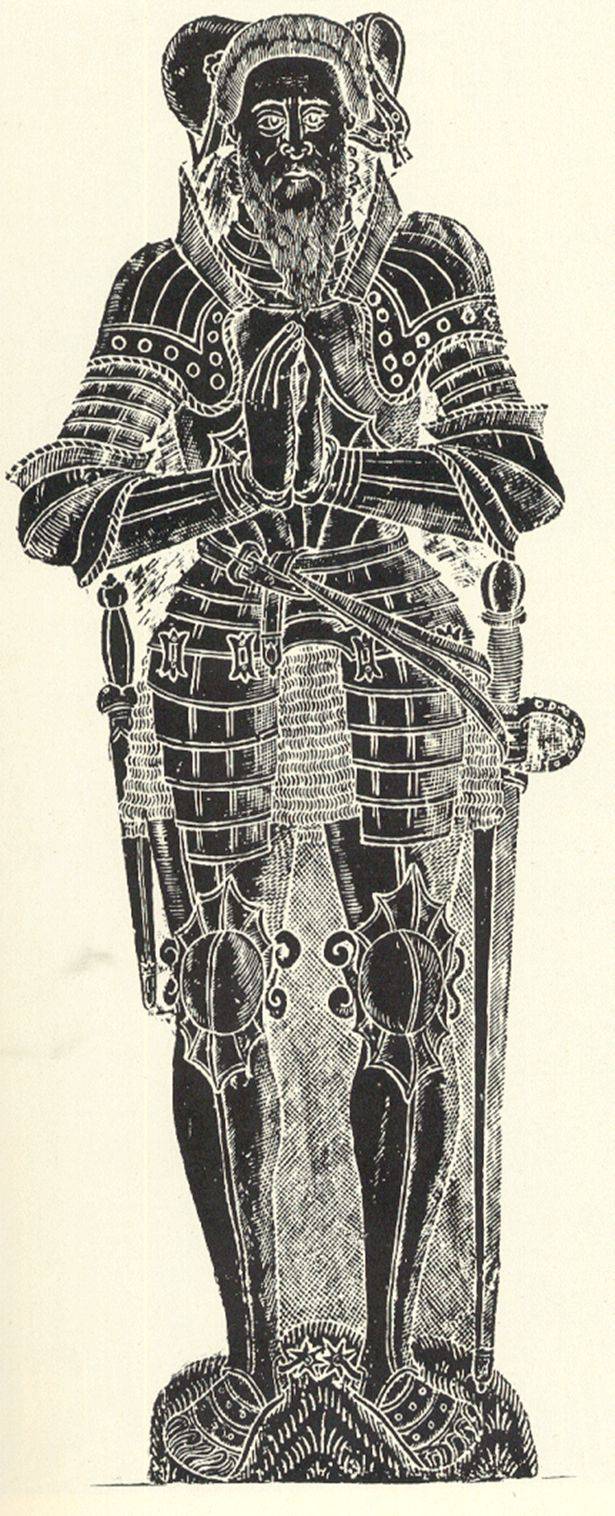
Brass Alexander Newton - on her honored veteran in old-fashioned armor
Part of the breasts show us warriors in full cuirassier equipment in "three quarters", that is, armor to the knees, and lower on their legs again, boots with cuffs. And the leggy, usually very massive to cover the "plump, stuffed with cotton pants!
Effigy again show that many knights wore patched robes over their armor. First surco, then a shorter jupone, and often covered them with heraldic images.
For example, this distinguished Richard Fitzluis (d. 1528) depicted on the breaststroke in the church Ingrave, Essex with four wives at once! Again, he wore “white armor,” but with a chain mail skirt, tasset and caftan no worse than that of the Black Prince, all embroidered with his family emblems. There were brasses in other countries as well, such as Lukas Gorki’s brass (d. 1475) in Poznań Cathedral in Poland, and Ambroise de Villiers (d. 1503) in Notre-Dame du Val Abbey in France, and he too shown in heraldic dress!
In general, the study of knightly equipment in Western Europe without a thorough study of effigy and breaststroke as sources today is simply impossible.
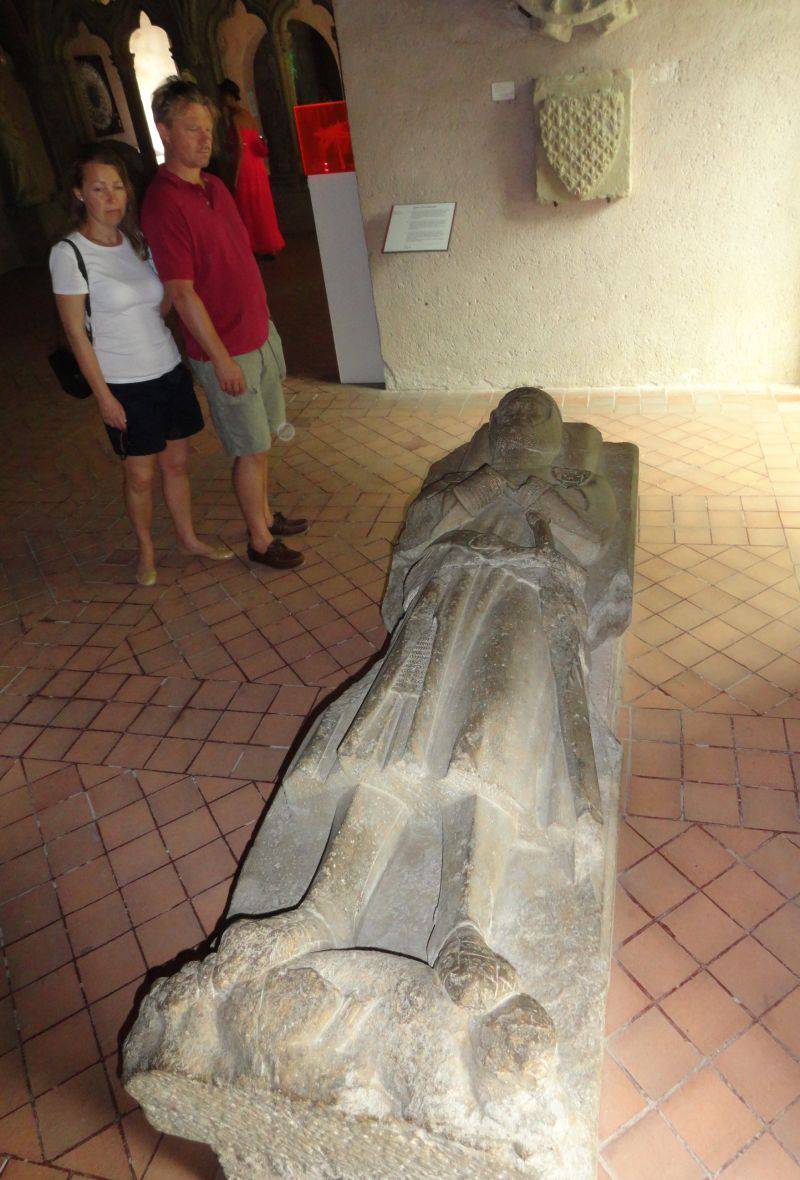
Information